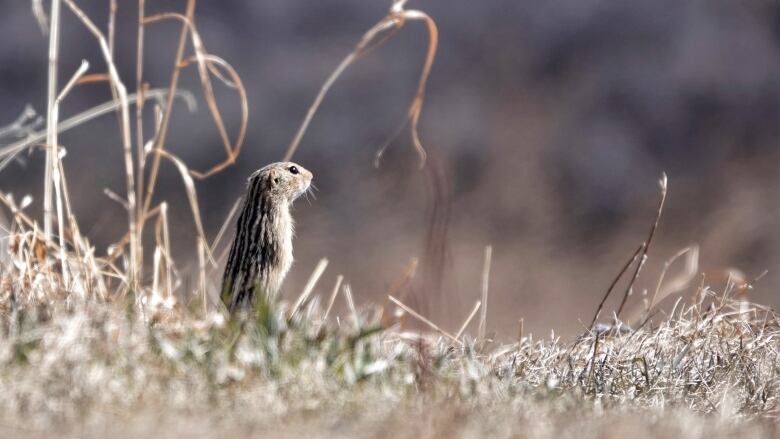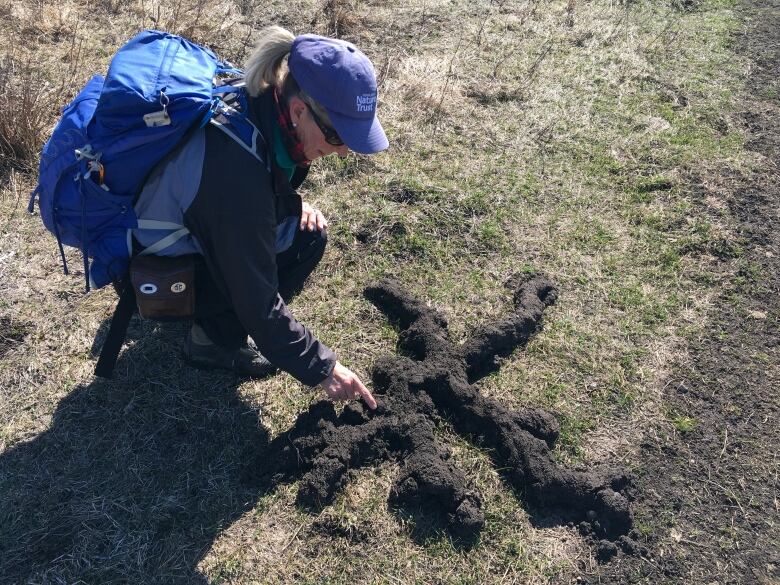Fur-lined cheek pouches and dirt-moving rodent teeth: Fun facts about Alberta's ground squirrels
Alberta is home to several species of ground squirrel with unique characteristics

The Richardson's ground squirrel is the most common "gopher" around here, but there are some lesser-known relatives roaming the foothills and fields of Alberta.
Naturalist Brian Keating headed south of Calgary recently and encountered three of them in one afternoon — one least chipmunk, one thirteen-lined ground squirrel, and dozens of pocket gophers.
Keating headed to the 4,800-acre Ann & Sandy Cross Conservation Area just off Highway 22x.
The land, donated to the province for the protection of wildlife habitat and conservation education, has a series of well-marked hiking trails and an education centre — and is a great place to spot wildlife.
"The trail we did was a 10-kilometre loop, and before we hardly got out of the parking lot, we'd already seen about a dozen deer," Keating told The Homestretch.
Keating also caught a glimpse of an elusive least chipmunk.
He says they are the smallest of the chipmunk species, and can weigh as little as 25 grams, or less than one ounce.

The least chipmunks stay active all winter by living in their burrows. To feed what Keating calls their "hyper metabolism," the chipmunk will scatter-hoard food in concealed pits beneath logs in their burrows.
They don't exactly hibernate, Keating said, but they enter a sort of torpor, and wake up every so often to eat from their food caches.
One rodent that does hibernate is the thirteen-lined ground squirrel, which Keating calls the best dressed of the ground squirrels.
Their fur coats are delicately striped with13 white lines and they are slightly smaller than the Richardson's ground squirrel.
Keating spotted — and photographed — the thirteen-lined ground squirrel at the picnic area, where they are more likely to be hanging out. He said there have been reports of an increased number of the thirteen-lined squirrel in that area of the Ann & Sandy Cross Conservation Area.

Unlike pocket gophers, which are active all winter, these ground squirrels hibernate after putting on a good layer of fat.
In October, they enter a subterranean nest, curl up in a ball, and drop their breathing rate from up to 200 breaths pet minute, down to one breath every five minutes.
Keating said pocket gophers do live 99 per cent of their lives underground, and are commonly mistaken for moles — but that there are no moles in Alberta.
Moles primarily eat worms, and have tiny unapparent eyes and teeth. Pocket gophers, on the other hand, eat vegetation like roots and shoots, have huge teeth and visible eyes.
Pocket gophers also have handy fur-lined cheek pouches, which they use to transport bits of plant food that they gather underground.
Keating said it is extremely rare to spot a pocket gopher, but they do emerge at night — and are often eaten by owls.
"They are often found in the pellets of owls, so obviously they do come out at night," Keating said. "I have never seen one above the ground."
Jay Ingram, who hosts the podcast Anthropomania, captured a rare encounter with a pocket gopher in 2017.
My next paper: "Awareness Deficit in Rodents" <a href="https://t.co/sI6vAdh0gK">pic.twitter.com/sI6vAdh0gK</a>
—@jayingramOne of the pocket gopher's unique skills is the ability to use their teeth to loosen soil, without getting any dirt in their mouths — by closing their lips behind their long incisors.
People will write to Keating and ask how to deal with moles in their backyards, pointing to the dirt mounds as proof of the "mole," Keating said, adding that the dirt mounds are actually from pocket gophers.
Pocket gophers are ecologically important creatures, Keating said, but are capable of destroying gardens and lawns as they dig for roots.
"All the mounds of dirt the pocket gophers leave behind have no apparent hole, so the dirt seems to erupt from the ground," he said, adding they can make up to 300 soil mounds in a year while moving more than four tons of soil.
Their tunnels can be extensive, down to two metres in depth with food storage areas, sleeping chambers, latrines, and near the surface, shallow forage tunnels.
The elusive pocket gophers can live about five years in the wild and are active all year round.
For more stories about Alberta's wildlife from naturalist Brian Keating, visit his website and check out these stories:
With files from The Homestretch.